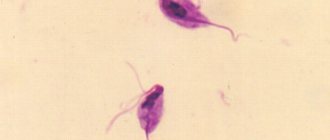Discussions on whether Mycoplasma hominis is pathogenic for women periodically resume.
But the opinion that such microorganisms still cause harm to the female body is dominant.
Too often mycoplasmas are found in women with signs of vaginitis, colpitis, cervicitis and salpingitis.
Long-term carriage of the infection reliably leads to infertility or pregnancy pathology.
At the same time, against the background of antimicrobial treatment, in parallel with the cleansing of the body from Mycoplasma hominis, inflammatory phenomena also subside.
The ability to become pregnant and bear a healthy child is restored.
Characteristics of Mycoplasma hominis
Biologically, mycoplasmas are unique microorganisms. They contain both DNA and RNA, but do not have a cell wall. They are forced to obtain the substances necessary for life from other cells, that is, in fact, they are parasites.
The family is large and includes several types of microorganisms.
For dermatovenerology, the following are most relevant:
- M. hominis
- M. genitalium
- M. orale
- M. primatum
- M. fermentans
- Ureaplasma
The most common species in the human population is Mycoplasma hominis.
This is due to the paucity of the clinical picture, mild manifestations of inflammation and the high contagiousness of the infection.
People do not notice the symptoms and continue to spread pathogens. But mycoplasma infection does not go away completely without a trace. Quite serious consequences await women.
Microbes parasitize on the surface of epithelial cell membranes and intracellularly. During their life processes, they release peroxides and enzymes that damage host cells. The epithelium of the genitourinary tract of the human body turned out to be the most sensitive to mycoplasma hominis. There they parasitize quite successfully, causing sluggish chronic inflammation.
The infection is very contagious, since due to the absence of a cell wall, our immune system practically does not notice mycoplasmas. That is, even if a small number of microbes get on the sensitive epithelium, the disease will develop almost 100%.
Interestingly, the first Mycoplasma hominis was discovered and identified in men. But women more often learn that symptoms of inflammation and various complications of the reproductive organs are caused by mycoplasma.
Prevention
At the moment, measures to prevent mycoplasmosis are no different from measures to prevent other sexually transmitted infections.
It is important to remember that asymptomatic carriage of mycoplasmas in apparently healthy people does not reduce their etiological role in the development of chronic infections of the urogenital tract.
To prevent infection, as well as for timely detection of mycoplasma infection, it is necessary:
- 1Use of barrier contraception from the moment of sexual activity;
- 2Full examination of the sexual partner, in case of refusal of a barrier method of contraception;
- 3Detection of infections of the urogenital tract before conception, when planning pregnancy;
- 4Sanitary education of the population.
What are the signs of infection
Symptoms in women are caused by an inflammatory process in one or another part of the genital and urinary organs.
How do they get infected?
The main route of transmission of infection is unprotected sex.
The following options also have a certain significance in infection with urogenital mycoplasmosis:
- contaminated household items
- insufficiently sterilized gynecological instruments
- dirty hands
In addition to damage to the genitourinary organs, mycoplasmosis of the respiratory tract sometimes occurs, but it is not the subject of this article. Women become infected when microorganisms enter the vaginal mucosa during unprotected sexual intercourse.
The ability of mycoplasmas to attach to sperm deserves special attention. During ejaculation, motile sperm carry pathogens directly into the uterine cavity and fallopian tubes. This explains mycoplasma inflammation of the internal organs of the female reproductive system.
However, mycoplasma hominis is found in many women during preventive examinations. The patients themselves do not make any complaints; signs of inflammation are not detected or are minimal.
What tests should be taken for symptoms of mycoplasmosis?
Since the manifestations of mycoplasmosis are nonspecific, i.e. are similar to the clinical picture of many other sexually transmitted infections; a comprehensive examination will be required to confirm the diagnosis.
- Flora smear. This is the simplest diagnostic method; in paid medical centers it can be performed in just an hour. It will indicate the presence of inflammation in the reproductive tract, and will also help to exclude a number of sexually transmitted infections with similar symptoms (bacterial vaginosis, atypical forms of candidiasis, etc.). Many people are interested in the norm of mycoplasma in a smear in women, but it is worth saying that mycoplasma cannot be detected with conventional microscopy.
- Cytological examination to determine the condition of cervical cells in cases of suspected endocervicitis or dysplasia.
- PCR diagnostics of mycoplasma hominis and parvum. In addition, it is recommended to be examined for other sexually transmitted infections, since mycoplasmas are often found in association with other microorganisms - ureaplasma, chlamydia, etc. All this must be taken into account when prescribing treatment.
- General urine analysis for existing symptoms of urethritis and cystitis.
- Ultrasound of the genital organs if inflammation of the ovaries or tubes is suspected.
- Hysteroscopy and biopsy are prescribed in case of suspected uterine factor infertility.
- Ultrasound of joints when they are affected.
What diseases are caused by mycoplasmas in women?
Mycoplasma hominis are not able to actively move. Therefore, the primary focus of inflammation always occurs in the area where the pathogens enter. Then the pathogens gradually spread through the blood and lymph flow to all genital organs.
Typical pathological processes in women caused by Mycoplasma hominis:
- vaginitis, colpitis
- cervicitis
- salpingitis, salpingoophoritis
- endometritis, parametritis
- pelvioperitonitis
- urethritis, quickly turning into cystitis
These are “early” diseases that develop a relatively short time after infection. There are also long-term consequences and complications: joint damage, infertility.
Vaginitis and colpitis
The most common manifestations are in women. The reason is clear: it is the vagina and external genitalia that come into contact with pathogens first.
Whether they are on the surface of the penis, the skin of the hand or in the ejaculate. Inflammation develops after an incubation period of 7-14 days. It can be shortened to 3 or extended to 25 days.
Then the symptoms appear:
- slight itching in the external genitalia and vagina
- scanty discharge of a serous nature, often they can only be detected by a speck on the underwear
- burning sensation when urine hits the vulva
The peculiarity of mycoplasma vaginitis is that its symptoms are mild; many women do not notice them at all. The mucous membranes of the vagina and vulva may become red and swollen a week after sex. Copious serous or serous-purulent discharge may appear. Most likely, such symptoms are caused by another pathogenic flora.
Along with Mycoplasma hominis, gonococci, chlamydia, trichomonas and other STIs are often transmitted. In such cases, inflammation is acute. The inguinal lymph nodes become enlarged, which does not happen with isolated infection with M. hominis.
Cervicitis
Inflammation of the epithelium lining the cervical canal is even less noticeable than vaginitis and colpitis. Some women feel discomfort in the lower abdomen and pelvis, which intensifies in the middle of menstruation. Sometimes there is scanty, drip-like discharge from the external genitalia. That's all.
If cervicitis occurs brightly, with pain, copious discharge, then its cause is not Mycoplasma hominis, but another flora: M. genitalium, gonococci, and so on.
Salpingitis and salpingoophoritis
Mycoplasmas are capable of quickly penetrating the surface of sperm into the internal genital organs of a woman. Therefore, inflammation of the fallopian tubes (salpingitis) separately, and in combination with damage to the ovaries (salpingoophoritis), is far from uncommon.
The incubation period is slightly shortened. Inflammation can be noticed by mild discomfort in the lower abdomen.
Over time, menstrual disorders develop: the cycle gets disrupted, periods become more abundant and more painful.
Endometritis, parametritis
Due to the constant renewal of the endometrium during menstruation, significant harm to the uterus is not caused.
Many women do not even notice any discomfort and consider themselves completely healthy. This continues until the moment of conception.
Delayed endometrial renewal leads to the fact that it is colonized by mycoplasmas and loses its functionality.
According to statistics, up to 40% of cases of fetal death in the early stages are associated with mycoplasma infection that was not diagnosed in time.
Inflammation of the periuterine tissue (parametritis) is rarely provoked by Mycoplasma hominis. It occurs without a pronounced clinical picture.
Complaints of discomfort in the lower abdomen, mild malaise, and a slight increase in body temperature may be disturbing.
Pelvioperitonitis
A rare process when pathogens on sperm (more often) or in other ways (with lymph, less often) pass through the fallopian tubes and enter the peritoneum lining the pelvic cavity.
In such cases, there is pain in the lower abdomen, urination becomes painful, and the temperature rises.
Urethritis and cystitis
Isolated urethritis in women is rare; a combination of urethritis and cystitis is more typical for them.
In this case, the following phenomena attract attention:
- increased urge to urinate
- constant discomfort in the bladder area
- pain and burning when urinating
Due to irritation of the inflamed mucous membranes of the vulva by urine, disturbing and annoying itching of the genitals remains in the pauses between trips to the toilet.
Mycoplasmosis in pregnant women
Pregnancy is always an additional burden on all body systems. Accordingly, his protective powers are reduced at this time. And this can serve as a trigger for the disease if the woman was a carrier of the protozoa.
Developing infection with mycoplasma in women during pregnancy in the first or second trimester is fraught with miscarriages and the so-called “frozen pregnancy,” when the embryo stops developing.
In later stages, the risk of premature birth increases. It intensifies if the infection spreads to the amniotic sac, since in this case the waters may break prematurely.
During childbirth, the mother infects the child. This is fraught with the development of meningitis. It is possible for a newborn to become infected during childbirth, when passing through infected fallopian tubes (this is how girls become infected much more often).
After childbirth (natural or by cesarean section) or abortion, acute endometritis (acute postpartum infection) may develop.
Against the background of mycoplasmosis after delivery or artificial termination of pregnancy, there is a high probability of developing endometritis.
Therefore, when mycoplasmas are detected, treatment is required. However, it is not recommended to be carried out in the first trimester, since the drugs can negatively affect the development of the fetus and lead to pathologies of its internal organs and systems.
Read more about the treatment of mycoplasma during pregnancy >>
If mycoplasmosis is detected during pregnancy, it is necessary to carry out treatment, preferably from the second trimester . After all, it is in the first 3 months that all organs are fully formed, and taking medications can affect them too, which will be irreparable in the future.
Only a qualified doctor should decide on treatment and prescribe the drug, after assessing all the risks.
In addition, not all drugs are approved during pregnancy; pregnant women are usually treated with Josamycin.
Respiratory mycoplasmosis
This type of mycoplasmosis is caused by the microorganisms mycoplasma pneumonia, which affects the respiratory tract as a whole. With respiratory mycoplasmosis, both the upper (ARI) and lower (pneumonia) parts of the respiratory tract are affected. The incubation period lasts up to one month, but in most cases it is 1-2 weeks.
When the upper respiratory tract is affected, acute respiratory infections in most cases are expressed by rhinitis (inflammation of the nasal mucosa). The patient's condition is satisfactory.
When the lower respiratory tract is affected, leading to pneumonia, symptoms of intoxication are observed, fever and chills also occur (possibly a non-acute onset). This type of pneumonia is resistant to both penicillin and its semi-synthetic analogues during treatment. There may be cases with complications expressed in the transition to pneumosclerosis or bronchiectasis.
This type of disease affects both parts of the respiratory system. The incubation period of the disease can be up to thirty days, often less. If there is damage to the upper respiratory tract, it is usually rhinitis; if the lower respiratory tract is affected, pneumonia occurs, accompanied by symptoms of intoxication, fever and chills. It must be said that such pneumonia is resistant to penicillin drugs and their synthetic analogues. Complications of pneumonia in the form of pneumosclerosis or bronchiectasis are also observed.
Types of pathogens
Mycoplasma hominis belongs to the group of opportunistic microorganisms (due to this, it does not always lead to the appearance of pathological processes and does not require therapeutic therapy) and can cause the formation of a disease called mycoplasmosis. We will try to understand what mycoplasma hominis is, what features of the course and treatment of mycoplasmosis in women are in this article.
Mycoplasma genitalium (mycoplasma genitalium) is the causative agent of urogenital mycoplasmosis, a sexually transmitted disease. This pathogenic microbe often causes urethritis and other infectious and inflammatory pathologies of the genital organs. Mycoplasma genitalium is a very small microorganism that cannot be diagnosed using light microscopy and is highly resistant to a number of antibiotics from the penicillin and cephalosporin group.
- mycoplasma hominis, mycoplasma genitalium, ureaplasma urealiticum - refer to microorganisms that cause genitourinary mycoplasmosis, which is the most common form;
- mycoplasma pneumonia - refers to microorganisms that cause infections of the respiratory system through inflammation, affecting the lungs, bronchi and throat.
The disease mycoplasmosis itself, caused by these microorganisms, selects organs such as the throat, bronchi, lungs (respiratory system in general) and the genitourinary tract (urogenital mycoplasmosis) as the lesion.
- nagging pain in the lower abdomen (in cases where the uterus and appendages are inflamed);
- vaginal discharge, mostly clear;
- problems during urination (unpleasant sensations, itching);
- discomfort during sexual intercourse (pain);
- threat of premature birth;
- discharge of amniotic fluid earlier than expected;
- risk of miscarriage;
- the possibility of pneumonia in a woman in labor, which in some cases leads to meningitis in a newborn.
More about the consequences:
Folk recipes
(consult your doctor!)
- St. John's wort and crabgrass. You need to prepare a mixture of St. John's wort leaves and flowering plant flowers in a ratio of 1: respectively. For 600 ml of boiling water you need to take 3 tbsp. l. vegetable mixture, keep in a water bath for 10 minutes, then filter. Standard dosage: 200 ml three times a day 15 minutes before meals. Treatment lasts at least three weeks;
- St. John's wort and elderberry. To treat the infection, you need to prepare a mixture of 2 parts St. John's wort leaves, 3 parts black elderberry bark and 4 parts grass elder roots. For 1 liter of boiling water you need to take 5 tbsp. l. Leave this mixture in a water bath for a quarter of an hour, then leave for another hour and strain. The entire decoction is drunk within one day in several doses;
- Medicinal collection. You need to mix 3 parts each of immortelle, birch leaves and knotweed and 4 parts each of plantain and bearberry. The mixture is poured overnight with cold water in a ratio of 2 tbsp. l of vegetable raw materials per 400 ml of water. The next morning, the drug should be boiled over low heat for several minutes, then cooled and strained. Dosage regimen: ½ glass 3-4 times a day;
- Douching. Douching with a decoction of medicinal herbs will be effective in the treatment of mycoplasmosis. For therapy, you can use various decoctions, but a mixture of oak bark and boron uterus in a ratio of 2 is especially effective: The mixture is poured with boiling water, left for half an hour, filtered through gauze and used for douching;
- Garlic. Garlic contains many antimicrobial agents. This product is extremely effective in the treatment of various infectious diseases, in particular mycoplasmosis. A woman needs to eat 2-4 cloves of garlic every day. You can also make a garlic-based dressing sauce. To do this, 150 g of garlic is crushed and mixed with 150 ml of vegetable oil, salt and lemon juice are added to taste. This product can be used instead of sauces. It's tasty and very healthy;
- Drugs to strengthen the immune system. The appearance of mycoplasma infection is often associated with a decrease in the body's defenses. Immunomodulatory agents help fight infection. Such drugs include vitamin C-rich infusions of rose hips, pine or spruce needles or cranberries. To prepare the medicine for 2 cups of boiling water you need to take 2 tbsp. l. medicinal component, leave to infuse in a thermos overnight, then strain and drink during the day. It is better to alternate means. You can add honey to taste.
Delayed manifestations in women
All early processes caused by Mycoplasma hominis in women are characterized by a sluggish, hidden and often asymptomatic course. But this does not mean that the infection goes away without leaving a trace and does not affect your health in the future.
Long-term carriage of Mycoplasma hominis, or rather, smoldering inflammation of the internal genital organs of a woman, leads to several serious problems:
- overgrowth of the fallopian tubes with adhesions – tubal infertility
- chronic intoxication of the body
- problems with conception, early miscarriages
- pathology of pregnancy
- risks of exacerbation of genital infections with the slightest episodes of weakened immunity
Joint problems are not typical for infection with Mycoplasma hominis, but nevertheless they do occur. The reason is a mixed infection.
Women very rarely become infected with an isolated strain of M. hominis; usually, several STIs are “clung” at the same time. In this case, 6-10 months after infection the joints may begin to ache.
As for infertility, it has a dual nature. Some women fail to conceive because the egg does not pass through the sealed fallopian tubes into the uterus. Others experience recurring miscarriages.
The harm of Mycoplasma hominis during pregnancy is that the microbes contaminate the placenta.
At the same time, it becomes inflamed and necrotic in places. Such damage leads to chronic feto-placental insufficiency with malnutrition and fetal development abnormalities.
Childbirth through the natural birth canal is also dangerous: if the baby does not become infected in utero, then this will definitely happen during childbirth. And this is dangerous in terms of severe respiratory forms of mycoplasma infection in newborns. They are usually weakened, and the prognosis in such cases is quite difficult.
Because of these features, all women with difficulties in conceiving or bearing are recommended to undergo examination for mycoplasmosis.
Causes of the disease
This infection belongs to the group of sexually transmitted diseases and is quite common. Women suffer from it more often than men. In a woman’s body, mycoplasma hominis most often manifests itself, which affects the mucous membrane of the genital organs. Bacteria are transmitted from one partner to another during unprotected vaginal intercourse. Anal and oral sex are considered safe, since mycoplasmas colonize only the mucous membrane of the genitourinary system.
In rare cases, infection occurs through household means. This can be caused by using a shared towel or bed linen. However, the causative agent of mycoplasmosis is very sensitive to fluctuations in temperature and humidity, and quickly dies in the external environment.
The development of mycoplasma in some women can occur in a latent form without pronounced symptoms. In this case, the woman does not begin treatment for the disease, and it becomes chronic. In this case, signs may appear against the background of decreased immunity or the effect of negative factors on the woman’s body:
- stress, emotional stress, depression, chronic fatigue;
- systemic diseases;
- seasonal decrease in immunity;
- effects of toxic substances, harmful production factors;
- immunosuppressive therapy, chemotherapy, radiation;
- pregnancy.
Diagnostics
Traditional methods used to diagnose bacterial infections often fail in relation to mycoplasmas. The reason is the structural features of these microorganisms. Very small sizes, location directly on the cell membrane of the epithelium, or even intracellular localization of pathogens.
In this regard, four approaches are considered optimal:
- special microscopy techniques
- serodiagnosis
- gene diagnostics
- culture method
Each of them has its own characteristics, disadvantages and advantages. Therefore, venereologists have to select a diagnostic method individually for each patient.
Indications for examination of women
Screening and mass examination, due to the difficulties described above, are not done.
Indications for laboratory tests are:
- chronic recurrent inflammatory phenomena of the reproductive system
- disturbing itching of the genitals
- menstruation disorders
- problems with conception
- previously reported early miscarriages
- signs of inflammation (colpitis), identified during a visual preventive examination in the mirrors
In some cases, doctors may prescribe testing for Mycoplasma hominis in case of articular pathology associated with an infectious process of the genital organs.
Microscopy
The usual Gram stain and other options for identifying mycoplasmas are absolutely ineffective. The only thing that can be seen in the smear is signs of inflammation, colpitis or cervicitis. But this does not mean that a venereologist cannot do a quick smear test for mycoplasma hominis. To do this, they came up with an immunofluorescence reaction.
Direct (RPF) and indirect (RNIF) make it possible to detect species-specific antigens of microbes. That is, the analysis shows that it was mycoplasma hominis that caused the inflammation in the woman, and not other representatives of this family. Briefly, a sample (smear from the urethra, vagina, or cervical canal) is treated with serum containing phosphor-labeled antibodies to Mycoplasma hominis.
After washing the preparation, the sample is examined under a microscope under ultraviolet light. If the laboratory technician finds 10 or more luminous granules, the result is considered positive.
Immunofluorescence takes only 1.5-2 hours and has no equal in speed.
Positive results leave no room for doubt: you need treatment. But there is no particular point in relying on the negative results of RNIF or RPF in the presence of obvious signs of inflammation of the genital organs. Since with a low degree of contamination, mycoplasmas may simply not get into the sample for research. Then the venereologist continues the diagnostic search.
Serodiagnosis
Pathogens almost never enter the bloodstream directly; for this to happen, immunity must be practically absent. Postpartum septicemia also sometimes develops.
But antibodies to these pathogens appear in the blood just a few days after infection.
The diagnostic value of serological methods is that they can be used to monitor the effectiveness of the prescribed treatment: as the woman’s body is cleansed of mycoplasmas, the concentration of antibodies (titer) to them will decrease. Such information is very important in terms of preparing for pregnancy.
If there have been previous episodes of miscarriage, and during the initial examination, tests revealed high titers of antibodies to Mycoplasma hominis. Diagnostic material is venous blood. The required component is species-specific immunoglobulins (antibodies to mycoplasmas) or pathogen antigens.
Methods used:
- Aggregate hemagglutination reaction (AHA). It is carried out in 3-4 hours, the result is interpreted according to the 4-cross system (negative, weakly positive, positive, strongly positive). Assessment of titers is allowed - quantitative analysis
- Enzyme-linked immunosorbent assay (ELISA). Quite common and studied, has excellent sensitivity. But such tests for Mycoplasma hominis require up to a day of processing time. A wide titration range (up to 1 in 200) and hardware detection of reaction results make ELISA very popular
- Passive hemagglutination reaction. Similar to RAGA, but instead of Mycoplasma hominis antigens, RPHA is designed to search for antibodies to them. The result is also interpreted according to the 4-cross system, the minimum diagnostic titer is 1:32
Venereologists and gynecologists prescribe such tests.
The first ones are to find the source of chronic inflammation, itching and discomfort in the woman’s genital area.
The latter want to assess the risks for conception and successful pregnancy in women with unfavorable outcomes from previous pregnancy.
The disadvantage of serological tests for Mycoplasma hominis is that they are not highly specific. That is, the results may be positive if M. genitalium, M. orale, M. primatum, M. fermentans or U. urealyticum are detected. But the ability to monitor the effectiveness of treatment based on the dynamics of titers does not allow one to abandon such methods.
Gene diagnostics
This refers to molecular genetic techniques. The most famous and widespread is PCR (polymerase chain reaction). Based on the search for unique DNA sequences unique to Mycoplasma hominis.
The advantage is high accuracy of results and fast implementation. It is also a plus that a smear is used as a diagnostic material.
The disadvantage is the significant cost and rare cases of false positive detections of mycoplasma killed during treatment.
An alternative is new methods based on searching for unique RNAs. Such tests are also highly sensitive and exclude false positives. But they are expensive and therefore have not yet received widespread clinical use.
Cultural method
If it were not for the duration of the procedure, then this method would be more than enough for venereologists.
The diagnostic value of culture is undoubted:
- wide selection of diagnostic material - smear, urine, cervical scraping, amniotic fluid
- highest sensitivity
- unrivaled specificity
- assessment of drug resistance of pathogens identified in a particular patient
- the ability to assess the dynamics of the disease and response to treatment
The point is simple. The collected diagnostic material is placed on special nutrient media on which nothing except mycoplasma hominis can grow. Then they put it in a thermostat for cultivation and evaluate the result after 2-7 days. Apart from expensive real-time PCR, only culture allows one to draw the line between health, carriage and disease.
The indicator is called CFU (colony-forming units).
Displays the number of mycoplasma colonies grown from 1 ml of diagnostic material on a nutrient medium:
- no height – normal, woman is healthy
- A urine CFU of less than 10 to the 3rd degree, and a smear CFU less than 10 to the 4th degree, is regarded as a conditional norm; the question of the need for treatment is decided individually
- CFU more than the above numbers - the woman has mycoplasmosis, therapy is necessary
If the result is positive, the isolated pure culture is subcultured and tested for sensitivity to individual antibiotics.
This takes a few more days. But it allows you to exclude ineffective drugs from the course of therapy.
Replacing them with those to which the patient’s mycoplasma sensitivity is preserved individually.
Recovery criteria
After completing the full cycle of treatment, it is necessary to conduct a follow-up examination of both sexual partners to assess its effectiveness. This is due to the fact that taking antibiotics does not guarantee a 100% recovery.
Diagnostic tests are prescribed no earlier than 1 month after completion of the course. Control is carried out using the PCR method, and the material for research is smears from the urethra and vagina.
It is recommended to collect material from women approximately 2-3 days after the end of the next menstruation. A negative PCR result within three reproductive cycles in women and one month in men indicates the absence of infection in the body.
Treatment in women
The decision to start therapy for mycoplasmosis is made by the doctor. Therefore, at the slightest sign of inflammation of the genital organs or menstrual disorders, a woman should see a specialist venereologist or gynecologist.
There are two reasons for prescribing medications:
- test data on the active reproduction of mycoplasma hominis (high titer of immunoglobulins in the blood, a large number of CFU in the smear)
- questionable test data (moderate titers and CFU), but clear, noticeable signs of inflammation upon examination - colpitis, cervicitis, and so on
Ideally, the treatment regimen should be drawn up after obtaining the results of mycoplasma sensitivity in a particular woman.
If there is no time to wait, then antibiotics can be prescribed according to one of the regimens recommended by the Ministry of Health:
- Tetracycline 500 mg 2 times a day, 3 days
- Azithromycin 250 mg once a day, 3 days
- Ciprofloxacin 500 mg once a day, 3-5 days or 750 mg twice a day for 2 days
- Ofloxacin 200 mg twice daily for 2-5 days
- Doxycycline 100 mg per day for 3-5 days
If tests definitely show mycoplasma hominis, then erythromycins should not be used. This microorganism is resistant to them. Such prescriptions are allowed for routine treatment or in preparation for pregnancy.
Most drugs are taken orally, in tablet form.
A good effect is achieved by accompanying local treatment with vaginal suppositories based on antibiotics.
Parenteral forms of medications (injections, droppers) are usually not required.
Acute infection proceeds generally favorably. In chronic cases, the need for injections is also low. But in the form of injections, auxiliary drugs are often produced - immunomodulators, vitamins.
Injections are also needed to treat concomitant sexually transmitted infections.
Addition to antibacterial therapy
Since mycoplasmosis is often combined with a violation of the patient’s immune status, in our country treatment also includes other medications: immunomodulators, enzymes, adaptogens and vitamins, although all these groups of drugs do not have a wide evidence base.
Adaptogens are specific medicinal substances or plants that can increase the body’s nonspecific resistance to the effects of harmful physical and biological environmental factors.
This pharmacological group includes drugs of both natural and artificial origin. Natural adaptogens include extracts of eleutherococcus, ginseng, ginger and lemongrass.
They can be used 20-30 drops 30 minutes before meals up to 3 times a day. The course of application is about one month, 2-3 courses are carried out per year. Of the synthetic adaptogens, the most famous in Russia is trekrezan, which stimulates the production of the body’s own interferons, designed to correct immune disorders. It is used at 0.2 - 0.6 mg per day for two weeks.
In addition to antibacterial therapy for mycoplasmosis, proteolytic enzymes, or enzymes, are often prescribed. A group of proteolytic enzymes is used to resolve inflammatory adhesions in the urogenital tract, which helps release pathogens and make them accessible to the action of the antibiotic.
They are believed to have anti-inflammatory and immunomodulatory effects.
This makes it possible to reduce standard dosages of antibacterial agents and increases the effectiveness of therapy. The most common drugs in this group are alpha-chymotrypsin (5 ml IM every other day for 20 days) or Wobenzym (5 capsules orally 3 times a day before meals).
Let us repeat once again that adequate studies of these medications have not been conducted, so the need for their prescription is assessed by the attending physician (gynecologist, venereologist, urologist).
Pregnancy and treatment
A special approach is required for pregnant women. Due to the risks to the fetus, they try not to prescribe systemic therapy (in the form of tablets and injections). Then the main activities are allocated to local treatment and sanitization of the woman’s birth canal.
The use of suppositories based on azithromycin or other drugs active against mycoplasma hominis is allowed.
As for baths with antiseptics and the use of enzymes, now such prescriptions are individual in nature. For example, when pathogens are highly resistant to traditional antibiotics.










